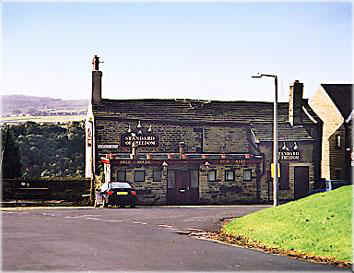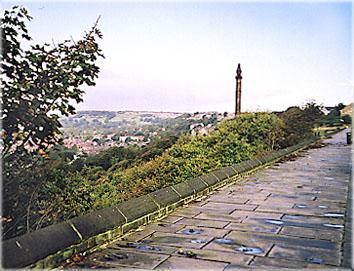
SKIRCOAT GREEN
As a child I lived in Skircoat Green, or on Skircoat Green as everybody says. Skircoat is one of the old townships which are now part of Halifax; the name means the buildings (cote) on the rocks (skirr) and perhaps referred to houses next to the green itself at the top of Copley Hill in front of what became the Bermerside estate, a mansion built by Edward Crossley, heir to one of Halifax’s Victorian textile magnates.
| Skircoat
or Skircoat Green is now a leafy pleasant middle-class suburb. In the old days
before the Class War ended in the 1980s, it was sometimes referred to as Fur
Coat Green, reflecting its image of affluence at a time when these things were
manifested rather differently from today. The rich built grand stone houses in
Skircoat in the nineteenth century and these were followed by less opulent but
still substantial detached, semi-detached and terrace houses. In the early
twentieth century more modest estates were built and since then more and more
green spaces have been filled in as the large gardens of the original
properties have been built on. Today any land in Skircoat is most desirable
and owners and builders compete for planning permission. Recently a new
development of so-called executive houses has been built around New Lane and
Fourteen Corners, an old footpath where as children we explored and played
with a freedom quite unknown to children today. So the Skircoat Green I knew
has been spoilt, just as my parents saw theirs spoilt as did their parents
before them. But its character remains essentially the same. |
The Standard of Freedom |
Next
to the green is a public house called the Standard of Freedom, my first local.
It was not until I moved to Rawdon a few years ago that I again became part of
a pub where regulars gather and greet one another affectionately. As older
teenagers before the days of jobs, marriages and mortgages, we met at the
Standard and returned there during university vacations before we were all
scattered by the four winds. The pub, we always understood, obtained its name
in 1846 in honour of the Repeal of the Corn Laws by Peel’s great reforming
ministry.

Savile Park
Skircoat’s
greatest asset is Savile Park, or Skircoat Moor as it was known until the
1860s. Generally it is still just referred to as The Moor. In the mid-1860s,
as Halifax expanded, the issue arose as to what was to happen to this vast
area of open land where historically freeholders had been able to graze their
livestock. Fortunately it was decided, with the agreement of the owner, Henry
Savile, who was prepared to sell his rights to the Corporation for a nominal
£100, that the area would remain undeveloped in perpetuity for the benefit of
the people of Halifax. As building land today it would be worth a fortune. So,
only a mile from the town centre are these many acres of land, which together
with Manor Heath, a park below The Moor, it is to be earnestly hoped will
never be built on. Successive generations in Halifax have every reason to be
forever grateful to Henry Savile and the Corporation of the time. In spring
crocuses carpet the fringes of The Moor, in summer the local agricultural show
is held there. At all times it is available for sport or for simply walking
the dog. There is not a high-rise in sight, not a supermarket, not a business
park. Not even a Big Issue seller.
|
Albert Promenade |
From
Albert Promenade, next to Savile Park, above The Rocks, there are spectacular
views across to Norland and Sowerby Bridge. Before the days of motor cars it
was a common leisure activity to walk up and down the Promenade and to wander
through Copley Woods below. Many still do. To the north of Albert Promenade is
Wainhouse Tower and the Crossley Heath School, once an orphanage before
becoming Crossley and Porter Grammar School. When Heath Grammar School, which
dated back to the reign of Elizabeth I, was, sadly, closed in the early 1980s,
the two schools amalgamated as Crossley Heath. It is still a selective grammar
school and one of the best state schools in the country. |
Skircoat Green is an example of what is often referred to nowadays as Middle England. Such places exist in most of our towns and cities, though not built of millstone grit and blown by the Pennine winds. It is the sort of place people want to live despite the sniffy disdain of metropolitan intellectuals for the provincial suburbs. It is safe, clean and civilised. You know the type of place – well cared-for properties, laurel and roses, law-abiding people, active churches, shops where items are sold in imperial measures and paid for in cash, bowling clubs and golf. If perhaps it’s not what it was (in retrospect the 1950s and ‘60s were a special time), it is better than most of the alternatives.
Photo's
and words by David.

